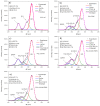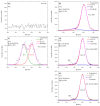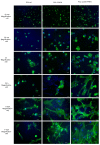Plasma-Coated Polycaprolactone Nanofibers with Covalently Bonded Platelet-Rich Plasma Enhance Adhesion and Growth of Human Fibroblasts
- PMID: 31010178
- PMCID: PMC6523319
- DOI: 10.3390/nano9040637
Plasma-Coated Polycaprolactone Nanofibers with Covalently Bonded Platelet-Rich Plasma Enhance Adhesion and Growth of Human Fibroblasts
Abstract
Biodegradable nanofibers are extensively employed in different areas of biology and medicine, particularly in tissue engineering. The electrospun polycaprolactone (PCL) nanofibers are attracting growing interest due to their good mechanical properties and a low-cost structure similar to the extracellular matrix. However, the unmodified PCL nanofibers exhibit an inert surface, hindering cell adhesion and negatively affecting their further fate. The employment of PCL nanofibrous scaffolds for wound healing requires a certain modification of the PCL surface. In this work, the morphology of PCL nanofibers is optimized by the careful tuning of electrospinning parameters. It is shown that the modification of the PCL nanofibers with the COOH plasma polymers and the subsequent binding of NH2 groups of protein molecules is a rather simple and technologically accessible procedure allowing the adhesion, early spreading, and growth of human fibroblasts to be boosted. The behavior of fibroblasts on the modified PCL surface was found to be very different when compared to the previously studied cultivation of mesenchymal stem cells on the PCL nanofibrous meshes. It is demonstrated by X-ray photoelectron spectroscopy (XPS) that the freeze-thawed platelet-rich plasma (PRP) immobilization can be performed via covalent and non-covalent bonding and that it does not affect biological activity. The covalently bound components of PRP considerably reduce the fibroblast apoptosis and increase the cell proliferation in comparison to the unmodified PCL nanofibers or the PCL nanofibers with non-covalent bonding of PRP. The reported research findings reveal the potential of PCL matrices for application in tissue engineering, while the plasma modification with COOH groups and their subsequent covalent binding with proteins expand this potential even further. The use of such matrices with covalently immobilized PRP for wound healing leads to prolonged biological activity of the immobilized molecules and protects these biomolecules from the aggressive media of the wound.
Keywords: COOH plasma; cell adhesion and spreading; cell viability; freeze–thawed platelet-rich plasma immobilization; nanofibers; polycaprolactone.
Conflict of interest statement
The authors declare no conflicts of interest.
Figures









Similar articles
-
Immobilization of Platelet-Rich Plasma onto COOH Plasma-Coated PCL Nanofibers Boost Viability and Proliferation of Human Mesenchymal Stem Cells.Polymers (Basel). 2017 Dec 20;9(12):736. doi: 10.3390/polym9120736. Polymers (Basel). 2017. PMID: 30966035 Free PMC article.
-
PRP of T2DM Patient Immobilized on PCL Nanofibers Stimulate Endothelial Cells Proliferation.Int J Mol Sci. 2023 May 5;24(9):8262. doi: 10.3390/ijms24098262. Int J Mol Sci. 2023. PMID: 37175994 Free PMC article.
-
Grafting of gelatin on electrospun poly(caprolactone) nanofibers to improve endothelial cell spreading and proliferation and to control cell Orientation.Tissue Eng. 2005 Jul-Aug;11(7-8):1149-58. doi: 10.1089/ten.2005.11.1149. Tissue Eng. 2005. PMID: 16144451
-
Biodegradable electrospun nanofibers coated with platelet-rich plasma for cell adhesion and proliferation.Mater Sci Eng C Mater Biol Appl. 2014 Jul 1;40:180-8. doi: 10.1016/j.msec.2014.03.065. Epub 2014 Mar 31. Mater Sci Eng C Mater Biol Appl. 2014. PMID: 24857481 Free PMC article.
-
Electrospun Polycaprolactone Nanofibers: Current Research and Applications in Biomedical Application.Adv Pharm Bull. 2022 Aug;12(4):658-672. doi: 10.34172/apb.2022.070. Epub 2021 Oct 3. Adv Pharm Bull. 2022. PMID: 36415646 Free PMC article. Review.
Cited by
-
Biocompatible Electrospun Polycaprolactone-Polyaniline Scaffold Treated with Atmospheric Plasma to Improve Hydrophilicity.Bioengineering (Basel). 2021 Feb 13;8(2):24. doi: 10.3390/bioengineering8020024. Bioengineering (Basel). 2021. PMID: 33668465 Free PMC article.
-
Fabrication of a low-kink-radius bilayer vascular scaffold incorporating a TPU stent fabricated via melt electrowriting and an electrospun PCL/PU/gelatin layer.Sci Rep. 2025 Jul 10;15(1):24894. doi: 10.1038/s41598-025-10547-4. Sci Rep. 2025. PMID: 40640341 Free PMC article.
-
Polycaprolactone Nanofibers Functionalized by Fibronectin/Gentamicin and Implanted Silver for Enhanced Antibacterial Properties, Cell Adhesion, and Proliferation.Polymers (Basel). 2024 Jan 17;16(2):261. doi: 10.3390/polym16020261. Polymers (Basel). 2024. PMID: 38257060 Free PMC article.
-
Well-Blended PCL/PEO Electrospun Nanofibers with Functional Properties Enhanced by Plasma Processing.Polymers (Basel). 2020 Jun 22;12(6):1403. doi: 10.3390/polym12061403. Polymers (Basel). 2020. PMID: 32580496 Free PMC article.
-
A Novel Nanofiber Hydrogel Loaded with Platelet-Rich Plasma Promotes Wound Healing Through Enhancing the Survival of Fibroblasts.Med Sci Monit. 2019 Nov 18;25:8712-8721. doi: 10.12659/MSM.919812. Med Sci Monit. 2019. PMID: 31739310 Free PMC article.
References
-
- Manakhov A., Kedroňová E., Medalová J., Černochová P., Obrusník A., Michlíček M., Shtansky D.V., Zajíčková L. Carboxyl-anhydride and amine plasma coating of PCL nanofibers to improve their bioactivity. Mater. Des. 2017;132:257–265. doi: 10.1016/j.matdes.2017.06.057. - DOI
Grants and funding
LinkOut - more resources
Full Text Sources
Research Materials

